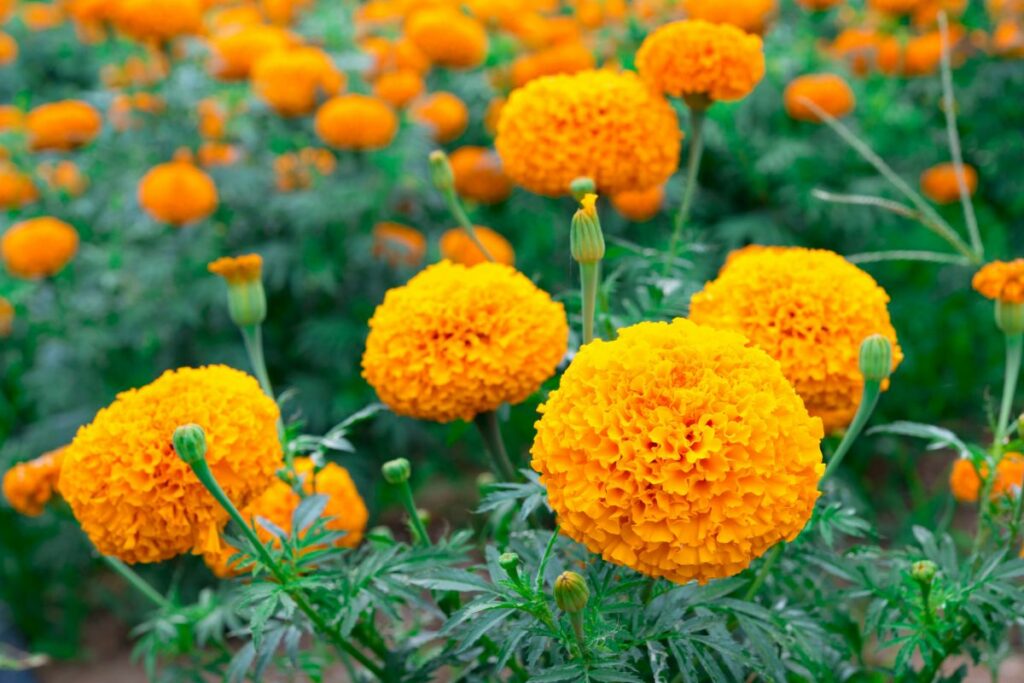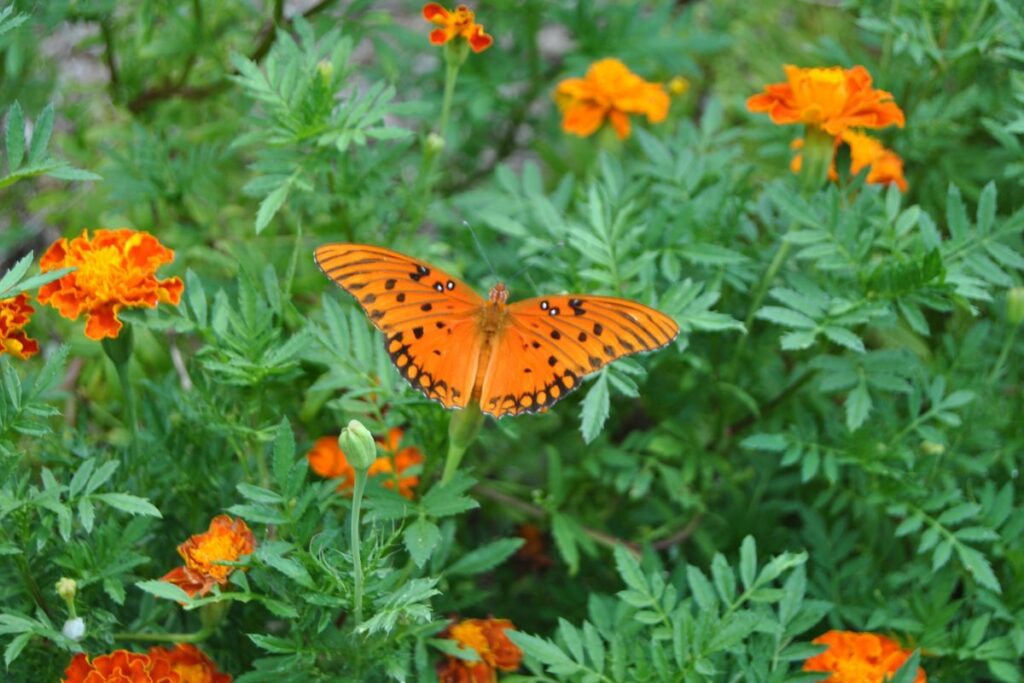Marigolds serve as more than just a charming addition to your garden aesthetics. Integrating them into your vegetable garden can work wonders, not only enhancing the garden’s visual appeal but also boosting its health and vitality. Their presence is key to inviting beneficial insects that aid in pollination and natural pest control, creating a vibrant and productive ecosystem in your backyard.
The versatility of marigolds extends beyond their ornamental value; they have practical applications that could spark your interest in incorporating them into your garden. Their distinctive aroma and the natural compounds they produce offer a dual function—they attract the right kind of garden allies while keeping pesky intruders at bay. Growing marigolds among your vegetables could be a strategic move you might want to consider.
1. Why Growing Marigolds is Easy

Growing marigolds is a joyful task due to their low-maintenance nature.
- Soil Flexibility: They are not picky about soil.
- Sunshine Requirement: Abundant blossoms require generous sunlight.
- Planting Ease: Direct sowing outdoors is an option. They typically sprout in under 10 days.
- Self-Propagation: Leaving spent flowers on the plant allows for natural reseeding.
For an orderly garden:
- Seed Collection: Manually collect seeds to control their spread.
- Planned Planting: Choose specific areas for planting to avoid a scattered look.
In gardens, marigolds are a go-to flower for their adaptability and generous blooming with minimal effort.
2. Marigolds are Edible
Marigolds, beyond their ornamental appeal, are a delightful addition to your culinary endeavors. Their vibrant blooms serve not just as eye candy in your garden, but they can also enhance dishes with their edible petals. Incorporate the blossoms into salads for a splash of color, or adorn your baked treats like cupcakes with these natural, edible decorations. Enjoy experimenting with these blossoms to elevate the aesthetics and taste of various meals.
3. How Marigolds Serve as Trap Crops
- Attract and Distract Pests: Position marigolds strategically around your garden to lure tomato fruit borers away from your vegetables.
- Slug Deterrent: Incorporate these blossoms in close proximity to your veggies to act as a natural barrier against slugs.
- Bold Action Required: While some marigold plants may succumb, promptly removing and disposing of pests found on them protects your main crop.
4. Using Marigolds to Keep Pests Away
- Whiteflies: Marigolds contain limonene, deterring these pests.
- Cabbage moths & Mexican bean beetles: Likewise, they are repelled by marigolds.
- Snakes: The presence of marigolds may discourage snake activity.
| Pest Type | Effectiveness |
|---|---|
| Whiteflies | High |
| Cabbage moths | Moderate |
| Mexican bean beetles | Moderate |
| Snakes | Undetermined |
Claims that marigolds repel deer and rabbits are not well-supported by evidence.
5. Marigolds’ Ability to Repel Nematodes

Understanding Nematodes
Nematodes, commonly known as roundworms, are minute, threadlike creatures—some of which benefit the soil by aiding in nutrient cycling. On the flip side, several species, such as root-knot nematodes, cause significant harm to plants by feeding on their roots. It’s important to identify and manage parasitic types before they cause widespread damage.
Marigolds’ Role in Nematode Control
Marigolds stand out for their ability to fend off these pests. They secrete a substance, α-terthienyl, that discourages nematode presence and supports beneficial soil microorganisms. By offering a less hospitable environment, marigolds function as an undesirable host and may serve as a decoy, allowing your main crops to thrive undisturbed. To amplify their protective effect, consider interplanting marigolds with veggies or incorporating them into your crop rotation plan.
- Effective Usage:
- Plant alongside vegetables as a repellent.
- Utilize marigolds in crop rotation to enhance soil health.
- Allow time for their nematode-deterrent effects to maximize.
The Most Potent Marigold Varieties
Concerning nematode suppression, French marigolds (Tagetes patula), along with varieties ‘Golden Harmony’, ‘Petite Harmony’, ‘Nemagold’, ‘Goldie’, and ‘Petite Gold’, top the list. They possess higher levels of the key compounds that deter nematodes. For optimal results, sow these marigolds ahead of your vegetable crops—preferably three to four months in advance—to permit the development and release of protective agents within the soil.
- Recommended Varieties:
- Tagetes patula (French marigold)
- ‘Golden Harmony’
- ‘Nemagold’
- ‘Petite Gold’
- ‘Goldie’
- ‘Petite Harmony’
These strategies can substantially mitigate the impact of nematodes but might not eradicate them entirely. For severe infestations, integrate additional control methods and consider cultivating nematode-resistant plant varieties.
6. Marigolds Attract Pollinators
Marigolds serve as a beacon for various pollinating insects, thanks to their bright colors and easily accessible pollen. As these plants bloom from the onset of summer until the first hard frost of fall, they provide a consistent source of nectar.
- Accessible Pollen: Varieties like ‘Little Gem’ marigolds, known for their open centers, offer easy access to pollen for bees and other insects.
Duration of Bloom:
- Long Blooming Period: Select marigold cultivars remain vibrant for an extended period.
- Short Bloomers: Mix ‘Little Gem’ with longer-blooming types for sustained garden color.
Plant Variety:
- Mix in marigolds with double flowers to diversify the attractants for different pollinator species.
By incorporating marigolds with various blooming cycles and floral structures, you create a dynamic and inviting environment for a host of pollinators.
7. Butterflies Love Marigolds

- Select Specific Flowers: Mountain marigolds.
- Result: Your vegetable garden becomes a favored spot for butterflies.
8. Other Helpful Bugs Enjoy Marigolds
- Ladybugs
- Hoverflies
- Lacewings
- Parasitic Wasps
Your marigolds serve as a beacon, drawing in a diverse array of insects that act as natural pest control. These allies, including ladybugs and lacewings, target common garden nuisances like aphids and caterpillars. By welcoming these predatory insects, your plants, such as arugula and other herbs, remain healthier and less damaged by harmful pests.
9. Use Marigolds to Make Food Coloring
Marigolds offer an economical alternative to saffron for imparting a soft yellow hue to foods. Their petals serve as a source of natural dye, perfect for:
- Coloring icing: Enhance your baked goods with vibrancy.
- Culinary uses: Enliven stews and soups.
- Crafting soaps: Create visually appealing homemade soaps.
Interestingly, hens consuming marigold petals may produce eggs with deeper yellow yolks.
10. Marigolds as a Fabric Dye
- Material Compatibility: Ideal for wool, cotton, hemp, and silk.
- Color Extraction: Achieve a vibrant yellow by boiling marigolds.
- Dye Fixative: Add alum to ensure dye adherence.
Preparation Steps:
- Gather marigold petals.
- Boil in water to release dye.
- Introduce alum to fix to fabrics.
Experiment to create rich, natural hues using marigold blossoms for your textile projects.
11. Make Essential Oils with Marigolds

- French Marigolds: Rich scent ideal for essential oil extraction.
- Versatility: Beneficial in aromatherapy, anti-parasitic treatments, and as a calming agent.
- Perfumery: Infused with sandalwood to create the distinct “attar genda”—a blend exuding a sweet and fruity aroma.
12. Use Marigolds for Soap and Beauty Products
Incorporate marigold petals and essential oils into your soaps for a subtle, natural aroma that offers relaxation with each use.
- Soaps: Blend marigold for gentle scent and purity.
- Shampoos & Creams: Enrich standard recipes with marigold essence for added benefits.
Experiment with marigold in your personal care formulations to elevate the sensory experience.
13. Marigolds as Beautiful Cut Flowers
Marigolds boast vibrant hues that can brighten any space. Consider snipping a few to craft a delightful arrangement in your living space.
- Vase Varieties: Display them in unique containers like hollowed-out pumpkins for a seasonal twist.
- Bouquet Design: Craft a small cluster exclusively of marigolds for a concentrated pop of color.
- Festive Garlands: Intertwine them into garlands, integrating tradition and beauty.
- Mixed Arrangements: Pair them with assorted blooms for a varied and striking floral composition.
Marigolds hold special significance in cultural celebrations, often seen in Indian weddings and Mexico’s Day of the Dead festivities. For personal decor, a straightforward approach can yield stunning results:
- Step-by-Step Simplicity: Create your own marigold centerpiece with ease, enhancing the appeal of your home.
14. Dry Marigolds for Lasting Decorations
By preserving marigolds, your floral creations can enjoy longevity. Here’s a simple guide:
- Select a cluster of marigolds: Cut and gather them.
- Secure and suspend: Bind the stems and dangle them upside-down.
- Optimal environment: Choose a space that’s warm with minimal humidity and provide ample ventilation, avoiding direct sun exposure.
Over the span of 2-4 weeks, the marigolds should fully dehydrate, ready for your various projects. These dried blooms can be a component in crafts or even used to concoct a revitalizing tea blend, particularly when combined with dried mint.
15. Enrich Your Soil with Chopped Marigolds
Upon concluding the growth period of marigolds, trimming and incorporating them into the earth enhances soil fertility.
- Organic matter will increase, nurturing the ground.
- Marigold integration can suppress harmful nematodes.
- Live plants are required for the α-terthienyl effect.
- Enhanced organic levels may boost beneficial microbes that continue to deter nematodes.
Incorporate these cuttings directly into your garden’s soil to augment its health and composition.
Enhancing Your Veggie Garden with Marigolds
Incorporating marigolds into your vegetable garden brings a plethora of advantages. The following are six strategic approaches for utilizing marigolds to amplify the health and vigor of your garden:
Intermix Marigolds with Vegetables: Position marigolds randomly among your plants. This not only adds a splash of color but also supports a diverse ecosystem.
Clustered Planting: Group multiple marigolds together. They’re excellent at seducing a variety of pollinators and beneficial insects that keep pests at bay.
Row Interspersion: Nestle small assemblies of marigolds between the rows of your fruits and vegetables to create a synergistic effect that fosters a thriving garden.
Perimeter Guardians: Encircle your vegetable beds with marigolds. Their vibrant blooms act as a living fence, adding beauty while offering protection.
Pioneering Growth: Utilize marigolds as an inaugural crop in your rotation plan. They’re adept at preparing the ground for subsequent plantings.
Soil Protector: Deploy marigolds as a cover crop. Their presence helps sustain soil moisture, curtails erosion, and enhances soil quality over time.
Any strategy you choose to employ will contribute to a more productive and robust garden. Embrace the versatility of marigolds and customize their placement according to the unique layout and needs of your vegetable garden.

